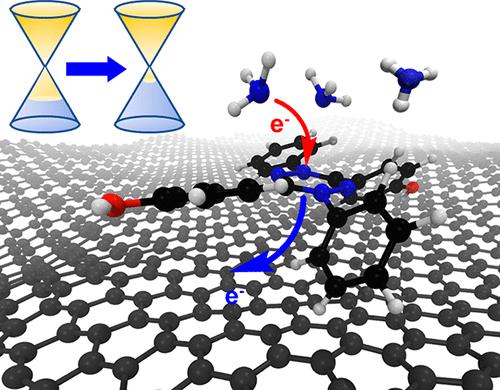Our official English website, www.x-mol.net, welcomes your feedback! (Note: you will need to create a separate account there.)
Pushing Down the Limit of NH3 Detection of Graphene-Based Chemiresistive Sensors through Functionalization by Thermally Activated Tetrazoles Dimerization
ACS Nano ( IF 17.1 ) Pub Date : 2022-06-22 , DOI: 10.1021/acsnano.2c01095 Sonia Freddi 1, 2 , Daniele Perilli 3 , Luca Vaghi 3 , Mauro Monti 3 , Antonio Papagni 3 , Cristiana Di Valentin 3 , Luigi Sangaletti 1
ACS Nano ( IF 17.1 ) Pub Date : 2022-06-22 , DOI: 10.1021/acsnano.2c01095 Sonia Freddi 1, 2 , Daniele Perilli 3 , Luca Vaghi 3 , Mauro Monti 3 , Antonio Papagni 3 , Cristiana Di Valentin 3 , Luigi Sangaletti 1
Affiliation

|
An easy and cost-effective method is presented to functionalize graphene through thermally activated dimerization of 2,5-diaryltetrazoles. Consistently with the experimental spectroscopic results, theoretical calculations demonstrate that during the thermal treatment a dimerization process to tetrazine is energetically more favorable than covalent grafting. Since both the functionalization method by thermal activation and the use of tetrazoles have never been considered before to prepare graphene-based chemiresistors, this represents a promising approach to develop graphene-related sensing platforms. Five different 2,5-diaryltetrazoles have been tested here for the effective functionalization of low-defect graphene layers on silicon nitride. Based on these layers, an array of sensors has been prepared for testing upon ammonia exposure. The tests on the sensing performances clearly show sensitivity to ammonia, extending the current range of ammonia detection with a graphene-based chemiresistor down to the sub-ppm range, as results from a benchmarking with data available in the literature. Furthermore, all sensors perform better than bare graphene. Density functional theory (DFT) calculations, carried out on a model of the best performing layer of the array, provided the theoretical framework to rationalize the sensing mechanism and disclose a dual role played by the tetrazine molecules, (i) acting as ammonia concentrators and (ii) mediating the electron transfer between ammonia and graphene.
中文翻译:

通过热活化四唑二聚化功能化降低基于石墨烯的化学电阻传感器的 NH3 检测极限
提出了一种简单且经济高效的方法,通过 2,5-二芳基四唑的热活化二聚化来功能化石墨烯。与实验光谱结果一致,理论计算表明,在热处理过程中,四嗪的二聚过程在能量上比共价接枝更有利。由于以前从未考虑过通过热激活功能化方法和使用四唑来制备基于石墨烯的化学电阻器,因此这代表了开发石墨烯相关传感平台的有前途的方法。这里测试了五种不同的 2,5-二芳基四唑,用于有效功能化氮化硅上的低缺陷石墨烯层。基于这些层,已经准备了一系列传感器用于测试氨暴露。传感性能测试清楚地显示了对氨的敏感性,将基于石墨烯的化学电阻器的当前氨检测范围扩展到亚 ppm 范围,这是根据文献中可用数据进行基准测试的结果。此外,所有传感器的性能都优于裸石墨烯。密度泛函理论 (DFT) 计算,在阵列的最佳性能层模型上进行,提供了使传感机制合理化的理论框架,并揭示了四嗪分子所起的双重作用,(i) 作为氨浓缩器和(ii) 调节氨和石墨烯之间的电子转移。作为基准与文献中可用数据的结果。此外,所有传感器的性能都优于裸石墨烯。密度泛函理论 (DFT) 计算,在阵列的最佳性能层模型上进行,提供了使传感机制合理化的理论框架,并揭示了四嗪分子所起的双重作用,(i) 作为氨浓缩器和(ii) 调节氨和石墨烯之间的电子转移。作为基准与文献中可用数据的结果。此外,所有传感器的性能都优于裸石墨烯。密度泛函理论 (DFT) 计算,在阵列的最佳性能层模型上进行,提供了使传感机制合理化的理论框架,并揭示了四嗪分子所起的双重作用,(i) 作为氨浓缩器和(ii) 调节氨和石墨烯之间的电子转移。
更新日期:2022-06-22
中文翻译:

通过热活化四唑二聚化功能化降低基于石墨烯的化学电阻传感器的 NH3 检测极限
提出了一种简单且经济高效的方法,通过 2,5-二芳基四唑的热活化二聚化来功能化石墨烯。与实验光谱结果一致,理论计算表明,在热处理过程中,四嗪的二聚过程在能量上比共价接枝更有利。由于以前从未考虑过通过热激活功能化方法和使用四唑来制备基于石墨烯的化学电阻器,因此这代表了开发石墨烯相关传感平台的有前途的方法。这里测试了五种不同的 2,5-二芳基四唑,用于有效功能化氮化硅上的低缺陷石墨烯层。基于这些层,已经准备了一系列传感器用于测试氨暴露。传感性能测试清楚地显示了对氨的敏感性,将基于石墨烯的化学电阻器的当前氨检测范围扩展到亚 ppm 范围,这是根据文献中可用数据进行基准测试的结果。此外,所有传感器的性能都优于裸石墨烯。密度泛函理论 (DFT) 计算,在阵列的最佳性能层模型上进行,提供了使传感机制合理化的理论框架,并揭示了四嗪分子所起的双重作用,(i) 作为氨浓缩器和(ii) 调节氨和石墨烯之间的电子转移。作为基准与文献中可用数据的结果。此外,所有传感器的性能都优于裸石墨烯。密度泛函理论 (DFT) 计算,在阵列的最佳性能层模型上进行,提供了使传感机制合理化的理论框架,并揭示了四嗪分子所起的双重作用,(i) 作为氨浓缩器和(ii) 调节氨和石墨烯之间的电子转移。作为基准与文献中可用数据的结果。此外,所有传感器的性能都优于裸石墨烯。密度泛函理论 (DFT) 计算,在阵列的最佳性能层模型上进行,提供了使传感机制合理化的理论框架,并揭示了四嗪分子所起的双重作用,(i) 作为氨浓缩器和(ii) 调节氨和石墨烯之间的电子转移。



























 京公网安备 11010802027423号
京公网安备 11010802027423号